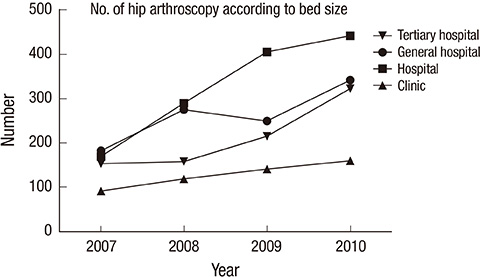J Korean Med Sci.
2014 Feb;29(2):277-280. 10.3346/jkms.2014.29.2.277.
National Trends of Hip Arthroscopy in Korea
- Affiliations
-
- 1Department of Orthopaedic Surgery, Seoul National University Bundang Hospital, Seongnam, Korea.
- 2Department of Orthopaedic Surgery, Chung-Ang University College of Medicine, Seoul, Korea. hayongch@naver.com
- KMID: 1789988
- DOI: http://doi.org/10.3346/jkms.2014.29.2.277
Abstract
- Hip arthroscopy has been reported to be useful and promising for the treatment of hip pathologies. However, it is not known whether the utilization of hip arthroscopy has increased in Korea. The purpose of this study was to evaluate national trends regarding the utilization of hip arthroscopy in Korea. We retrospectively reviewed nationwide data obtained from the Health Insurance Review and Assessment Service (HIRA). All new admissions for hip arthroscopy are recorded nationwide by HIRA using the ICD-10 code and the code for arthroscopic devices. Using archived data, we determined the trends in utilization of hip arthroscopy between 2007 and 2010. The number of hip arthroscopies increased more than twofold over the study period, from 596 to 1,262. A third of cases were performed in hospitals. Furthermore, a bimodal distribution was observed for men (20 to 24 yr and 45 to 49 yr) and an unimodal distribution for women (50 to 54 yr). Our results show an increasing trends in the utilization of hip arthroscopy from 2007 to 2010, which is in-line with recent findings of increased utilization with the rest of the world.
Keyword
MeSH Terms
Figure
Cited by 1 articles
-
Characteristics of Patients Diagnosed with Osteoporosis in South Korea: Results from the National Claim Registry
Hyun Koo Yoon, Young-Kyun Lee, Yong-Chan Ha
J Bone Metab. 2017;24(1):59-63. doi: 10.11005/jbm.2017.24.1.59.
Reference
-
1. Philippon MJ, Briggs KK, Yen YM, Kuppersmith DA. Outcomes following hip arthroscopy for femoroacetabular impingement with associated chondrolabral dysfunction: minimum two-year follow-up. J Bone Joint Surg Br. 2009; 91:16–23.2. Larson CM, Giveans MR. Arthroscopic management of femoroacetabular impingement: early outcomes measures. Arthroscopy. 2008; 24:540–546.3. Byrd JW, Jones KS. Arthroscopic management of femoroacetabular impingement: minimum 2-year follow-up. Arthroscopy. 2011; 27:1379–1388.4. Byrd JW, Jones KS. Prospective analysis of hip arthroscopy with 10-year followup. Clin Orthop Relat Res. 2010; 468:741–746.5. Matsuda DK, Carlisle JC, Arthurs SC, Wierks CH, Philippon MJ. Comparative systematic review of the open dislocation, mini-open, and arthroscopic surgeries for femoroacetabular impingement. Arthroscopy. 2011; 27:252–269.6. Voos JE, Rudzki JR, Shindle MK, Martin H, Kelly BT. Arthroscopic anatomy and surgical techniques for peritrochanteric space disorders in the hip. Arthroscopy. 2007; 23:1246.e1–1246.e5.7. McCarthy JC, Lee J. Hip arthroscopy: indications and technical pearls. Clin Orthop Relat Res. 2005; 441:180–187.8. McCarthy JC, Lee JA. Arthroscopic intervention in early hip disease. Clin Orthop Relat Res. 2004; (429):157–162.9. Colvin AC, Harrast J, Harner C. Trends in hip arthroscopy. J Bone Joint Surg Am. 2012; 94:e23.10. Montgomery SR, Ngo SS, Hobson T, Nguyen S, Alluri R, Wang JC, Hame SL. Trends and demographics in hip arthroscopy in the United States. Arthroscopy. 2013; 29:661–665.11. Park C, Ha YC, Jang S, Jang S, Yoon HK, Lee YK. The incidence and residual lifetime risk of osteoporosis-related fractures in Korea. J Bone Miner Metab. 2011; 29:744–751.12. Yoon HK, Park C, Jang S, Jang S, Lee YK, Ha YC. Incidence and mortality following hip fracture in Korea. J Korean Med Sci. 2011; 26:1087–1092.13. Lee YK, Jang S, Jang S, Lee HJ, Park C, Ha YC, Kim DY. Mortality after vertebral fracture in Korea: analysis of the National Claim Registry. Osteoporos Int. 2012; 23:1859–1865.14. Choi HJ, Shin CS, Ha YC, Jang S, Jang S, Park C, Yoon HK, Lee SS. Burden of osteoporosis in adults in Korea: a national health insurance database study. J Bone Miner Metab. 2012; 30:54–58.15. Korea National Statistical Office. accessed on 22 April 2013. Available at http://www.kosis.kr.16. Burman MS. Arthroscopy or the direct visualization of joints: an experimental cadaver study: 1931. Clin Orthop Relat Res. 2001; (390):5–9.17. Sampson TG. Complications of hip arthroscopy. Clin Sports Med. 2001; 20:831–835.18. Lee YK, Ha YC, Hwang DS, Koo KH. Learning curve of basic hip arthroscopy technique: CUSUM analysis. Knee Surg Sports Traumatol Arthrosc. 2013; 21:1940–1944.19. McCarthy JC, Lee JA. Hip arthroscopy: indications, outcomes, and complications. Instr Course Lect. 2006; 55:301–308.20. Philippon MJ, Schroder E Souza BG, Briggs KK. Hip arthroscopy for femoroacetabular impingement in patients aged 50 years or older. Arthroscopy. 2012; 28:59–65.21. Larson CM, Giveans MR, Taylor M. Does arthroscopic FAI correction improve function with radiographic arthritis? Clin Orthop Relat Res. 2011; 469:1667–1676.22. Konan S, Rhee SJ, Haddad FS. Hip arthroscopy: analysis of a single surgeon's learning experience. J Bone Joint Surg Am. 2011; 93:52–56.




